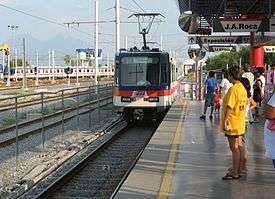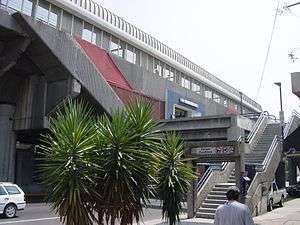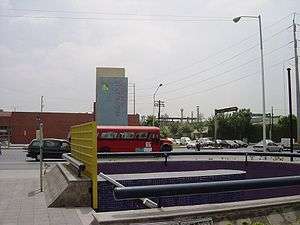Monterrey Metro
 | ||||||||||||||||||||||||||||||||||||||||||||||||||||||||||||||||||||||||||||||||||||||||||||||||||||||||||||||||||||||||||||||||||||||||||
 Train arriving at Talleres Station. | ||||||||||||||||||||||||||||||||||||||||||||||||||||||||||||||||||||||||||||||||||||||||||||||||||||||||||||||||||||||||||||||||||||||||||
| Overview | ||||||||||||||||||||||||||||||||||||||||||||||||||||||||||||||||||||||||||||||||||||||||||||||||||||||||||||||||||||||||||||||||||||||||||
|---|---|---|---|---|---|---|---|---|---|---|---|---|---|---|---|---|---|---|---|---|---|---|---|---|---|---|---|---|---|---|---|---|---|---|---|---|---|---|---|---|---|---|---|---|---|---|---|---|---|---|---|---|---|---|---|---|---|---|---|---|---|---|---|---|---|---|---|---|---|---|---|---|---|---|---|---|---|---|---|---|---|---|---|---|---|---|---|---|---|---|---|---|---|---|---|---|---|---|---|---|---|---|---|---|---|---|---|---|---|---|---|---|---|---|---|---|---|---|---|---|---|---|---|---|---|---|---|---|---|---|---|---|---|---|---|---|---|---|
| Native name | Sistema de Transporte Colectivo Metrorrey | |||||||||||||||||||||||||||||||||||||||||||||||||||||||||||||||||||||||||||||||||||||||||||||||||||||||||||||||||||||||||||||||||||||||||
| Owner | Nuevo León state government | |||||||||||||||||||||||||||||||||||||||||||||||||||||||||||||||||||||||||||||||||||||||||||||||||||||||||||||||||||||||||||||||||||||||||
| Locale | Monterrey, Nuevo León, México | |||||||||||||||||||||||||||||||||||||||||||||||||||||||||||||||||||||||||||||||||||||||||||||||||||||||||||||||||||||||||||||||||||||||||
| Transit type |
Light rail (Lines 1 and 2) Rapid transit (Line 3) | |||||||||||||||||||||||||||||||||||||||||||||||||||||||||||||||||||||||||||||||||||||||||||||||||||||||||||||||||||||||||||||||||||||||||
| Number of lines | 2[1] | |||||||||||||||||||||||||||||||||||||||||||||||||||||||||||||||||||||||||||||||||||||||||||||||||||||||||||||||||||||||||||||||||||||||||
| Number of stations | 31[1] | |||||||||||||||||||||||||||||||||||||||||||||||||||||||||||||||||||||||||||||||||||||||||||||||||||||||||||||||||||||||||||||||||||||||||
| Daily ridership | 467,000 (Q1 2018)[2] | |||||||||||||||||||||||||||||||||||||||||||||||||||||||||||||||||||||||||||||||||||||||||||||||||||||||||||||||||||||||||||||||||||||||||
| Annual ridership | 177.6 million (2018)[2] | |||||||||||||||||||||||||||||||||||||||||||||||||||||||||||||||||||||||||||||||||||||||||||||||||||||||||||||||||||||||||||||||||||||||||
| Website | STC Metrorrey | |||||||||||||||||||||||||||||||||||||||||||||||||||||||||||||||||||||||||||||||||||||||||||||||||||||||||||||||||||||||||||||||||||||||||
| Operation | ||||||||||||||||||||||||||||||||||||||||||||||||||||||||||||||||||||||||||||||||||||||||||||||||||||||||||||||||||||||||||||||||||||||||||
| Began operation |
1991 (Line 1)[3] 1994 (Line 2)[3] | |||||||||||||||||||||||||||||||||||||||||||||||||||||||||||||||||||||||||||||||||||||||||||||||||||||||||||||||||||||||||||||||||||||||||
| Operator(s) | Sistema de Transporte Colectivo Metrorrey | |||||||||||||||||||||||||||||||||||||||||||||||||||||||||||||||||||||||||||||||||||||||||||||||||||||||||||||||||||||||||||||||||||||||||
| Character | Elevated & underground | |||||||||||||||||||||||||||||||||||||||||||||||||||||||||||||||||||||||||||||||||||||||||||||||||||||||||||||||||||||||||||||||||||||||||
| Number of vehicles | 84 | |||||||||||||||||||||||||||||||||||||||||||||||||||||||||||||||||||||||||||||||||||||||||||||||||||||||||||||||||||||||||||||||||||||||||
| Train length | 2–3 cars | |||||||||||||||||||||||||||||||||||||||||||||||||||||||||||||||||||||||||||||||||||||||||||||||||||||||||||||||||||||||||||||||||||||||||
| Technical | ||||||||||||||||||||||||||||||||||||||||||||||||||||||||||||||||||||||||||||||||||||||||||||||||||||||||||||||||||||||||||||||||||||||||||
| System length | 32 km (20 mi)[2] | |||||||||||||||||||||||||||||||||||||||||||||||||||||||||||||||||||||||||||||||||||||||||||||||||||||||||||||||||||||||||||||||||||||||||
| ||||||||||||||||||||||||||||||||||||||||||||||||||||||||||||||||||||||||||||||||||||||||||||||||||||||||||||||||||||||||||||||||||||||||||
The Monterrey Metro (Spanish: Sistema de Transporte Colectivo Metrorrey), generally referred to as just Metrorrey is a fully grade-separated Light rail system in Monterrey, Nuevo León, Mexico. Line 1 is elevated. Line 2 is half a subway and half elevated. It is the newest of Mexico's light rail systems, with operation beginning in 1991,[3]. As of 2014, the system operated 40 high-floor electric trains,[2] along a total system of 31 stations with a length of 32 kilometers (20 mi).[2] As of June 2018, Line 3 is under construction.
Operations
Lines
The Monterrey Metro, officially known as Metrorrey has two lines with 31 stations.[1]
Line 1, which opened on April 25, 1991,[3] has 19 stations, runs through the center of the city from the north-west to the eastern part of the Monterrey Metropolitan Area. Built as an 18.5 km long line,[4] it runs parallel to the former 1887 Topo Chico tramline and is grade-separated as it runs on an elevated structure. A complete ride along this line takes about 27 minutes. Line 1 is linked to Line 2 at Cuauhtémoc station, located downtown.
Line 2 has 13 stations and is also fully grade-separated, partially on an aerial structure and partially subterranean. The first six-station segment, which opened on November 30, 1994,[3] was 4.5 km long and runs underground. Construction on a US$ 200 million expansion of Line 2 began on August 8, 2005.[3] The first segment of the expansion opened on October 31, 2007,[3] and added another three stations to the line. The second segment of the expansion was inaugurated on October 9, 2008[3] by Nuevo León Governor Natividad González Parás and Mexican president Felipe Calderón, and added another four stations to the line. This last segment runs on an aerial structure in the center of Avenida Universidad. The completed 12.5-kilometer (7.8 mi) route runs from Sendero to the Macroplaza with a station at the Universidad Autónoma de Nuevo León.[5]
Construction is in progress for a third rail line (Linea 3). Early in 2018, the state of Nuevo Leon signed a funding agreement to provide 600 million pesos to Metrorrey for continued construction on Linea 3. Up to that period, Metrorrey reported total expenditures on Linea 3 of over 10 billion pesos. The transit agency claims it will be spending these funds for viaducts, and station features, such as awnings, elevators, and escalators.[6]
Ridership
According to Mexico's National Institute of Statistics, Geography and Informatics, Metrorrey's two lines transported 177.6 million passengers in 2017, with a fourth quarter (Q4) 2013 monthly ridership average of 14,013,000, which corresponds to an average daily passenger load of 467,000 passengers.[2]
Fares
The following are the travel fares as of 2018:
- Single Trip - MXN4.50 (~USD0.22)
- 2 Trips - MXN8.00 (~USD0.39)
- Metrobus - MXN8.50 (~USD0.41)
Metrorrey also offers "Boletos Multiviaje" (multitrip tickets). These tickets are intended for recurrent users and they are sold in denominations ranging from 15 to 85 trips.
Since the opening of the extension of the Line 2, Metrorrey began offering the "Mia" Card, a rechargeable card that can be loaded with multiple trip credits. The "Mia" card can be initially purchased for MXN20 (~USD0.97) and can be recharged in increments ranging from MXN1 to MXN100. (~USD0.05 to ~USD4.83)
On May 16, 2009, Nuevo León governor Natividad González Parás announced that Metrorrey would be free for the following 60 days, as part of a program to reduce the effects of the economic downturn on citizens.[7]
Rolling stock
The Metrorrey system uses 84 high-floor articulated vehicles, used to form two- or three-car trainsets each, with the possibility of forming up to four-car trainsets. Some cars have an air-conditioning system. The first 23 cars were manufactured in 1990 by the Mexican government-owned Concarril (the National Railway Car Manufacturing Company) and the next 25 in 1992–93 by the Canadian company Bombardier, after it acquired Concarril in 1992, all 48 of these cars being built at a factory in Ciudad Sahagún, Mexico, and the two batches being "nearly identical".[4] Those 48 cars were followed by 22 that were built in Spain by CAF, with the remaining 14 vehicles built by Bombardier. Specifically, Metrorrey ordered 25 two-section MM-90 cabs in 1988, and 23 MM-90/2F cabs in 1990 from Bombardier; the latter type represents the second generation of the same vehicle equipped with high-tech components, including, among other things, asynchronous traction motors with the power supplied by catenary.
Transmetro
Metrorrey also has a bus system that uses exclusive and obligatory stops along its route. It has nine lines. On Metrorrey Line 1 there are four Transmetro lines, three in Talleres station and one in Exposición station. On Line 2 there are five more Transmetro lines, two at San Nicolas (Santo Domingo and Las Puentes) and three more at Sendero (Montreal, Fomerrey, and Apodaca). There is no additional fee, other than the standard Metro Ticket, to use Transmetro.
Future service
Although the Nuevo León Government performed studies to determine where a new Line 3 should be built, those plans were ultimately discarded when then 2012 presidential candidate, Enrique Peña Nieto promised to build new Lines 3 and 4 within his term. This plan shows that Line 3 will depart from current Line 2 terminal, General Anaya station, and will run underground through the Barrio Antiguo neighborhood. This line will then run in an elevated track outside the city center, with its terminus being the Metropolitan Hospital at the border between San Nicolás and Apodaca, and serving a total of nine stations. In July 2014, a contract was signed with CAF for 26 trains to run on Line 3.[8]
As of June 2018, Line 3 of Metrorrey is under construction. This line will be open in 2019.[6]
Gallery
 Interior of an MM-93 train
Interior of an MM-93 train Looking down into the ticketing area of Zaragoza Station
Looking down into the ticketing area of Zaragoza Station Ticket vendor
Ticket vendor Metrobus stops at Exposicion Station
Metrobus stops at Exposicion Station Transfer point at Cuauhtemoc Station
Transfer point at Cuauhtemoc Station Eloy Cavazos Station
Eloy Cavazos Station Parque Fundidora Station
Parque Fundidora Station Felix U. Gomez Station
Felix U. Gomez Station General Anaya Station
General Anaya Station Accessibility sign
Accessibility sign Transmetro in Talleres Station
Transmetro in Talleres Station
See also
References
- 1 2 3 "Red Metro" [Metro Network (map)] (in Spanish). Sistema de Transporte Colectivo Metrorrey. Archived from the original (jpg) on 2013-07-03. Retrieved 2013-08-06.
- 1 2 3 4 5 6 "Comunicaciones y transportes - Principales características del sistema de transporte colectivo metrorrey". Banco de Información Económica - Instituto Nacional de Estadísitica y Geografía (INEGI). Retrieved 2018-08-15.
- 1 2 3 4 5 6 7 8 "Sistema de Transporte Colectivo Metrorrey - Historia" [System of Collective Transport Metrorrey - History] (in Spanish). Gobierno del Estado de Nuevo León. Archived from the original on 2013-10-24. Retrieved 2013-08-06.
- 1 2 May, Jack (1994). "Mexico Says Sí to LRT: Light Rail South of the Border". 1994 Light Rail Annual & User's Guide, p. 7. Pasadena, CA (US): Pentrex. ISSN 0160-6913.
- ↑ "Siemens AG References". Siemens AG. Retrieved 2008-07-09.
- 1 2 Juarez, Pilar (March 29, 2018). "Reasignan 600 mdp para obras de Línea 3 del Metrorrey". Milenio. Retrieved June 2, 2018.
- ↑ Zúñiga Esquivel, Francisco (16 May 2009). "Nati dará agua y Metro gratis por dos meses" [Nati will give free Metro and water for two months]. Milenio (in Spanish). Archived from the original on 20 June 2009. Retrieved 3 September 2009.
- ↑ "Spain's CAF Wins Train Contract in Mexico". Latin American Herald Tribune. Retrieved June 3, 2018.
External links
![]()

